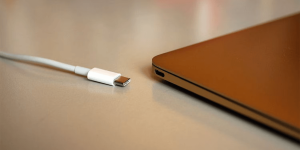USB-C Data Transfer Speeds: How Fast Can It Go?
In today’s digital age, where speed and efficiency are paramount, the USB-C connector has emerged as the champion of wired connectivity. Its oblong-shaped, reversible design and versatility make it the universal connector we’ve all been waiting for. However, as we increasingly rely on it for data transfer, a fundamental question arises: How fast can USB-C really go?
When Was USB-C Launched? Is USB-C Backward Compatible?
The USB-C journey began in August 2014 with the release of its final specification. This revolutionary connector, boasting a 24-pin reversible design, opened doors to a new era of connectivity. Unlike its predecessors, USB-C can supply more power, and it’s compatible with a wide array of connectors, including USB-A, USB-B, HDMI, DisplayPort, and even the trusty 3.5mm audio jack.
It’s essential to clarify that USB-C’s name solely refers to its physical form factor, not the USB protocol it supports. As a result, it accommodates USB 2.0, USB 3.1 Gen 1 (USB 3.0), USB 3.1 Gen 2, USB 3.2, USB4, and even Thunderbolt 3 and 4. Its slender design suits both mobile devices and power-hungry laptops, bridging the gap between the two.
While a direct USB-C to USB-A connection isn’t feasible, adapters come to the rescue, allowing you to connect your USB-C devices to older USB ports. However, such connections are limited to the capabilities of the USB-A or USB-B port.

USB-C Data Transfer Standards
USB-C’s versatility extends to supporting various protocols, each with distinct data transfer rates. These speeds range from 480Mbps to a mind-boggling 40Gbps, with the potential for even higher rates in the future. This means that seemingly identical USB-C cables can offer vastly different data transfer speeds.
Let’s break down some of the key USB data transfer standards:
USB 1.x
The inaugural USB standard, USB 1.x, arrived with speeds of 1.5 megabits per second (Mbps) for low-speed and 12 Mbps for full speed. It paved the way for more compact and portable devices by eliminating legacy ports like serial and PS/2.
USB 2.0
Launched in 2000, USB 2.0 improved on its predecessor, boasting a maximum data transfer speed of 480 Mbps.
USB 3.x
The third-generation USB protocol, USB 3.x, ushered in a significant speed boost. USB 3.2 Gen 2 x 2 utilizes multilane signaling, achieving data transfer speeds of up to 20Gbps.
USB4
USB4 incorporates Thunderbolt 3 and can tunnel additional protocols such as PCIe and DisplayPort. With the USB4 V2.0 spec, theoretical transfer rates reach 80 Gbps in bidirectional mode and 120 Gbps in asymmetric mode.
Thunderbolt 3
Intel’s once-proprietary Thunderbolt 3 standard utilizes a USB-C connector, supporting data transfer speeds of up to 40Gbps.
Thunderbolt 4
Thunderbolt 4 matches USB4’s maximum theoretical transfer speed but increases PCIe data requirements to 32Gbps from 16Gbps. Notably, there are several differences between Thunderbolt 4 and USB4.
The table below offers a comprehensive overview of these protocols and their corresponding speeds:
| Standard | Release Date | Maximum Speed | Marketing Names | Connector Types |
|---|---|---|---|---|
| USB 2.0 | 2000 | 480 Mbps | Hi-Speed | USB-A, USB-B, USB-C |
| USB 3.0/USB 3.1 | 2008/2013 | 5Gbps | SuperSpeed, USB 5Gbps | USB-A, USB-B, USB-C |
| USB 3.2 Gen 1 | 2011 | 5Gbps | SuperSpeed, USB 5Gbps | USB-A, USB-B, USB-C |
| USB 3.2 Gen 1×2 | 2017 | 10Gbps | – | USB-C |
| USB 3.2 Gen 2 | 2013 | 10Gbps | SuperSpeed+, USB10Gbps | USB-A, USB-B, USB-C |
| USB 3.2 Gen 2×2 | 2017 | 20Gbps | SuperSpeed USB20Gbps | USB-C |
| USB4 Gen 2×1 | 2019 | 10Gbps | – | USB-C |
| USB4 Gen 2×2 | 2019 | 20Gbps | USB20Gbps | USB-C |
| USB4 Gen 3 | 2019 | 20Gbps | – | USB-C |
| USB4 Gen 3×2 | 2019 | 40Gbps | USB40Gbps | USB-C |
| USB4 Gen 4 | 2022 | 80Gbps/120Gbps | USB80Gbps/120Gbps | USB-C |
Note: USB 3.0 was renamed USB 3.1 Gen 1 in 2013.
What Is the Maximum Theoretical Data Transfer Limit For USB-C?
The USB-C connector is capable of transferring data at astonishing speeds. While USB4 boasts theoretical speeds of 80 Gbps and 120 Gbps, these rates are yet to be realized in current market products. Thunderbolt 5, if it ever emerges, may also support similar speeds.
As of now, the highest achievable data transfer rate via USB-C, using USB4 and Thunderbolt 4, is 40 Gbps. This speed is available on select Apple, Intel, and AMD laptops released after 2020.
However, it’s crucial to understand that these speeds remain theoretical. Real-world usage can vary significantly due to factors such as cable length, cable quality, device compatibility, interference, and file type. Additionally, the speed of the storage drive being used plays a pivotal role. Modern PCIe SSDs outperform older HDDs, regardless of the USB standard used.
For those experiencing sluggish transfer speeds, there are several ways to expedite USB data transfer on Windows.
USB-C: The Lightning-Fast Connector of the Future
USB standards have evolved dramatically since their inception, promising ever-increasing speeds. In the near future, your USB version may matter less as rocket-speed data transfer becomes the norm. While many users may not fully utilize these speeds, the assurance of lightning-fast connectivity is comforting.
USB-C is not just a connector; it’s a gateway to a faster, more connected world. As our devices and needs evolve, USB-C stands ready to meet the demands of tomorrow’s digital landscape. Say goodbye to the days of slow data transfer and embrace the lightning-fast USB-C connector of the future.
In a world where time is of the essence, USB-C ensures that your data moves at the speed of thought, connecting you to what matters most.
Tomisin Olujinmi is a technology enthusiast and writer with a passion for exploring the world of connectivity. With years of experience in the field, Tomisin brings a wealth of knowledge about USB-C and its capabilities.
Comparative Table: USB Data Transfer Standards
| Standard | Maximum Speed | Key Features |
|---|---|---|
| USB 2.0 | 480 Mbps | Hi-Speed, USB-A, USB-B, USB-C |
| USB 3.0/USB 3.1 | 5Gbps | SuperSpeed, USB 5Gbps, USB-A, USB-B, USB-C |
| USB 3.2 Gen 1 | 5Gbps | SuperSpeed, USB 5Gbps, USB-A, USB-B, USB-C |
| USB 3.2 Gen 1×2 | 10Gbps | USB-C |
| USB 3.2 Gen 2 | 10Gbps | SuperSpeed+, USB10Gbps, USB-A, USB-B, USB-C |
| USB 3.2 Gen 2×2 | 20Gbps | SuperSpeed USB20Gbps, USB-C |
| USB4 Gen 2×1 | 10Gbps | USB-C |
| USB4 Gen 2×2 | 20Gbps | USB20Gbps, USB-C |
| USB4 Gen 3 | 20Gbps | USB-C |
| USB4 Gen 3×2 | 40Gbps | USB40Gbps, USB-C |
| USB4 Gen 4 | 80Gbps/120Gbps | USB80Gbps/120Gbps, USB-C |
In this article, we’ve unveiled the astounding speed capabilities of USB-C and how it’s shaping the future of connectivity. Whether you’re a tech enthusiast or someone seeking faster data transfer solutions, USB-C is here to revolutionize the way we connect and share information. Embrace the USB-C revolution and experience data transfer speeds that match the pace of your thoughts.




